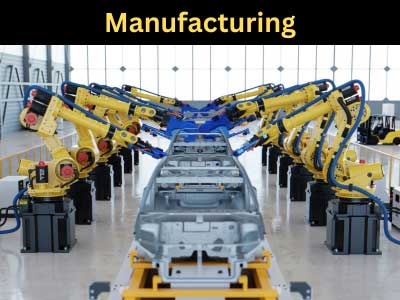Key Takeaway
Using robotics in manufacturing offers numerous benefits, including enhanced precision and repeatability, leading to consistently high-quality products. Robots can perform tasks with greater accuracy than humans, reducing the risk of errors and defects. Additionally, robots can work continuously without fatigue, eliminating issues related to tiredness, distraction, or the monotony of repetitive tasks.
By automating production processes, robotics also helps increase efficiency and productivity. This allows manufacturers to meet higher demands while maintaining consistent quality. Overall, robotics improves manufacturing efficiency, reduces operational costs, and enhances product quality, making it a valuable asset in modern manufacturing.
Increased Efficiency and Productivity with Robotics
Incorporating robotics into manufacturing significantly enhances efficiency and productivity. Robots are capable of performing repetitive tasks at a much faster pace than human workers, allowing manufacturers to boost production output without sacrificing quality. For new engineers, understanding the speed and precision of robots is essential to grasp the immense value they bring to production lines.
Unlike humans, robots can work 24/7, eliminating downtime caused by shift changes, fatigue, or breaks. This continuous operation leads to faster production cycles and more consistent performance. Robotics technology also allows for simultaneous multitasking, meaning different stages of production can run concurrently, reducing bottlenecks and overall lead times. By optimizing processes through robotics, manufacturers can meet tight deadlines, handle larger workloads, and remain competitive in an increasingly fast-paced industry.

Enhanced Precision and Quality Control
One of the standout advantages of robotics in manufacturing is the heightened level of precision they bring to operations. For tasks that require a high degree of accuracy, such as assembling small components or performing intricate welding, robots excel where human hands may fall short. Engineers can program robots to execute tasks with pinpoint accuracy, ensuring uniformity and minimizing the risk of defects.
This precision not only boosts product quality but also helps reduce waste caused by human error or inconsistencies. Robotic systems can detect variations in materials or production conditions in real-time and adjust accordingly. For example, a robotic arm performing quality inspections can instantly identify even the slightest flaw and flag the product for further review. With robots handling critical aspects of quality control, manufacturers can consistently meet high standards while reducing the time and cost associated with manual inspections.
Reducing Labor Costs and Human Error
Labor costs can be a significant portion of manufacturing expenses, particularly when considering skilled labor for repetitive or hazardous tasks. Robotics offers a solution by automating these tasks, allowing manufacturers to reduce their dependence on manual labor and, in turn, lower labor costs. This is especially valuable for large-scale operations where repetitive tasks dominate the production floor.
Robots not only reduce labor costs but also minimize human error. Human workers are prone to fatigue, distraction, and mistakes, especially when performing repetitive or monotonous tasks. Robots, on the other hand, can perform the same tasks repeatedly without variation or error. This consistency improves overall production quality and reduces costly mistakes that can lead to defective products, wasted materials, or production delays.
For new engineers entering the industry, understanding the financial and operational impact of robotics in reducing labor costs and errors is crucial. By leveraging robotic systems, manufacturers can save on labor expenses while boosting accuracy and efficiency.
Improving Safety in the Workplace with Robotics
Workplace safety is a top priority in manufacturing, and robotics plays a critical role in reducing risks associated with hazardous tasks. In many industries, workers are exposed to dangerous environments, such as high temperatures, heavy machinery, or toxic materials. Robots can take over these risky tasks, protecting workers from potential injury.
For example, robots can be used in chemical plants to handle toxic substances or in foundries to work near molten metals, removing the need for human exposure. This not only improves safety but also enhances productivity by allowing tasks to continue without the risk of accidents. Collaborative robots (cobots), designed to work alongside humans, further enhance safety by being equipped with sensors that prevent collisions and other workplace hazards.
For engineers, developing a solid understanding of how to integrate robotics into manufacturing processes while prioritizing safety is key to creating safer, more efficient work environments.
Flexibility and Scalability in Robotic Manufacturing
Another significant advantage of robotics in manufacturing is the flexibility and scalability it offers. Modern robotics systems are highly adaptable and can be reprogrammed or retooled to handle different tasks, making them ideal for companies that need to shift production quickly or introduce new product lines. This flexibility is particularly useful in industries with variable demand or short product lifecycles.
For instance, robots used in automotive manufacturing can be easily reprogrammed to produce different models or components with minimal downtime. This flexibility reduces the costs and time associated with retooling or training human workers for new tasks. Additionally, robotics enables manufacturers to scale production up or down based on market demand. By simply adding or adjusting robotic systems, companies can increase production capacity without the need for significant workforce expansion.
For engineers entering the industry, mastering the implementation of flexible and scalable robotics systems is essential for driving innovation and responding to shifting market needs.
Conclusion
Robotics is revolutionizing the manufacturing industry by offering unmatched advantages in efficiency, precision, and scalability. Robots are capable of performing tasks faster and more accurately than humans, which not only reduces labor costs but also minimizes errors and defects. In an increasingly competitive market, manufacturers that adopt robotics can maintain higher standards of quality while optimizing their production processes.
Moreover, robots enhance workplace safety by handling dangerous or repetitive tasks that would otherwise put human workers at risk. As manufacturing becomes more automated, the ability to integrate and master robotics will be essential for engineers. Embracing robotics means driving sustainable growth, meeting market demands more efficiently, and staying ahead of the curve in an industry that is continuously evolving toward greater automation.
